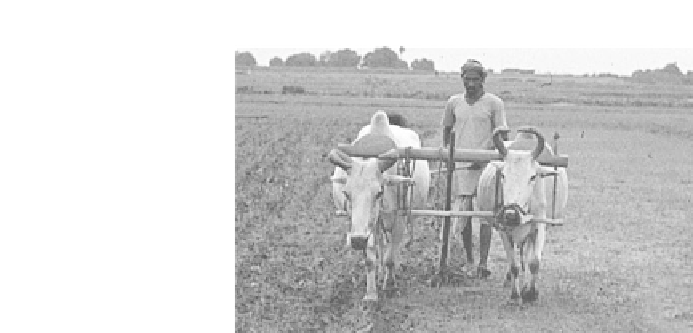Agriculture Reference
In-Depth Information
Figure
3.10.
Bullock-drawn plow in India.
Many maize varieties are able to produce grain under a relatively low soil fertility
level. Sorghum varieties have been developed in areas with low rainfall and low levels
of soil fertility. Modern varieties and economics demand that grain yields per hectare be
much higher than subsistence farmers in the tropics. In Ohio, a farmer will apply 180 kg
of nitrogen, about 90 kg of phosphate, and 160 kg of potash fertilizer per hectare to
obtain a yield of 8900 kg of maize from the same hectare.
6
Actual rates depend
greatly on fertilizer cost, projected sale price of the grain, and soil test results.
Chemical fertilizer rates can be reduced as much as 50 percent by growing a legume
crop the season before the crop is planted. The residual nitrogen fixed by the legume
crop is available to a crop up to 3 years after the legume is plowed under. Application
of animal manures also helps to reduce the need for chemical fertilizers. Under commer-
cial growing conditions, chemical fertilizers are preferred due to their lower cost.
Commercial farmers in developing countries will often use a minimal amount of
nitrogen fertilizer and supplement this with animal manures, compost, and a crop
rotation. The result is a lower yield but with the benefit of less cash investment in
the crop. Subsistence farmers depend almost entirely on nonchemical sources of nutri-
ents for their crop. Often this means a longer period between plantings of maize or
sorghum in the same field to permit buildup of nitrogen reserves.
3.2.8 Weeds, Insects, and Diseases
Weeds are a major problem for maize and sorghum. Commercial grain production uses
heavy applications of fertilizers that also contribute to rapid weed growth. Traditional
methods of weed control involve hand labor to pull or hoe weeds in a field. This is dif-
ficult even for small operations with only 1 to 2 ha fields. Large-scale commercial grain
production involves planting as much as 1000 ha, which is impossible to hand weed.
Mechanical weeding was practiced in the United States until the mid-1970s. A
tractor with special cultivator “sweeps” would spend hours passing up and down the
rows in a field stirring the soil between the rows to remove small weeds. Two to
three weeding operations were required for each crop; an expensive operation that








